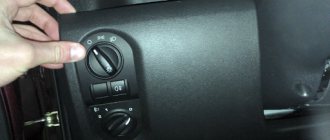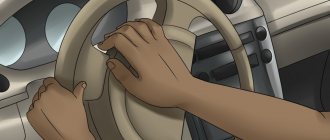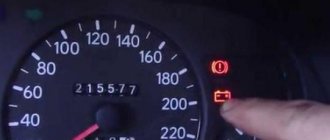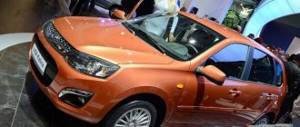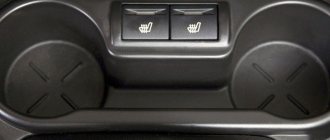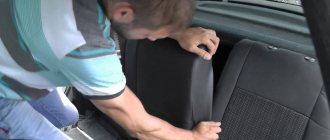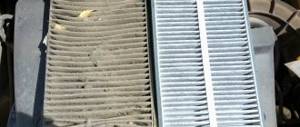Hi all. About six months ago, the license plate light stopped working. I thought, well, the light bulbs burned out. Only recently did I have the desire to change these light bulbs, I put new ones in - they don’t light up! I started looking at all the fuses - they were all intact! I immediately went to Drive in search of the truth. I found why the backlight might not be on yet.
Interesting? Then watch!
Last night we decided to remove the rear bumper from SancheZzz93 and take a look at the wiring. No sooner said than done! We remove the bumper.
We've removed it and are starting to look at the wiring. Wait, what is this?
AvtoVAZ engineers are simply geniuses! Doing factory wiring on twists is professionalism!
Well, what needs to be eliminated. We soldered it and put it in heat shrink.
To be on the safe side, as SancheZzz93 said: “If it’s sex, then only safe sex,” we went over it thoroughly with duct tape.
Now the backlight works! Well, then... I thought so... Anyway, since the bumper is removed, I’ll wash everything under it.
Um... My hands are itching... What else can I do useful while the bumper is removed... I remembered that the grant has a sore, it’s the grant itself - the junction of the bumper with the rear fender, I look - and it’s true that in some places the paint has rubbed down to the metal. Disorder! Take a jar of paint (KUDO, color 240 “White Cloud”, art. KU70240), tint it in several layers. We also tint the places where the rear headlights come into contact with the fender (they are also worn out there). We wait until it dries, smoke, tell jokes. ABOUT! I took the mastic with me in a bottle! We decided to blow it out, it wouldn’t be a waste, it would only be beneficial. Dooley, without regret, so as not to worry in the future, according to the principle “everything we could, we did.”
Have you lost your license plate light? Do you think it's a fuse? Do you think the light bulb has burned out? Nope) Everything is much cooler))) As they say without comment, look at the photo where the dog is buried...
Mileage: 12800 km
FakeHeader
Comments 21
I encountered the same problem. The hike will also have to take off the bumper. Too labor intensive? Besides unscrewing the bolts, is it difficult to take off and put in place?
About 30 minutes for everything, just don’t break the parking sensor sensor, everything is tight there
Are there all regular heads or are there Torx ones?
I don’t remember, my brain was cold in winter :)))
I don’t understand, is there a twist there?
Yeah, well, so as not to offend Avto VAZ too much, I’ll say this - it’s somehow not right.
For me it stopped burning in 2014 in August)))
it’s scary... how nothing is closed...
this is where it is?! At first the diodes stopped lighting, I took them out, and they were really burned out! I plugged in the factory ones, they work, the fuse is intact, they don’t light! I gave up on all this, and in the evening of the same day everything worked! Now again this bitch doesn’t work... I’ll get confused over the weekend, otherwise even the traffic cop was at home yesterday about this
Diagram and location of fuses VAZ 2110 2111 2112
Don’t know where the VAZ 2110, 2111, 2112 fuses are located or which fuse is responsible for the cigarette lighter, ignition or fuel pump? Today we will try to describe in detail the diagram and location of the VAZ 2110, 2111, 2112 fuse box with their decoding.
There are fuses on the driver's side, at the feet you can see a plastic door (see photo), opening which we can see the fuse box
Fuse box
The fuse box in Grant is located to the left of the steering column, near the light switches. To remove the cover and access the fuses and relays, pull the top left side of the cover towards you. It’s made conveniently, everything is at hand and you don’t have to climb anywhere when getting up from the driver’s seat. Maybe this is a hint that they will often have to be changed, or maybe just convenience - the developers know better.
F1 (15 A) - engine control unit, injectors, ignition coil, cooling fan relay, short circuit 2x2.
If you have problems with electronics, and replacing this fuse does not help, in the worst case scenario, you will have to reflash the ECU or replace it. Also, if this fuse blows, the injectors and ignition coil stop working, which makes engine operation impossible. Therefore, if the Grant does not start, check this fuse first.
F2 (30 A) - electric windows.
If they do not work and replacing the fuse does not help, try unplugging it completely or removing the terminal from the battery for a couple of minutes, then connect it again. In this way, all temporary errors should be reset and if this is the case, the power windows will work again.
F3 (15 A) - alarm . If it doesn’t work, check this fuse, as well as the emergency light button, its contacts and the functionality of the lamps.
F4 (20 A) - windshield wiper, airbag . If the airbag warning light on the instrument panel comes on, check this fuse. The problem could be either in it, or in the electronic unit, or in the pillows themselves.
If the windshield wiper does not work and this fuse is intact, also check relay K6, the power handle, the reliability of the connectors connected to it, as well as the electric wiper drive itself.
F5 (7.5 A) - terminal 15 of the ignition switch. If you have problems turning on the ignition, check this fuse, as well as the reliability of the wire connections to the lock terminals.
F6 (7.5 A) - reverse lamp . If it does not work, but this fuse is intact, check the lamp itself, as well as the contacts connecting the connectors to the headlight.
F7 (7.5 A) - Mass air flow sensor, adsorber valve, oxygen sensor, speed sensor . If the engine runs erratically, does not idle, or stalls spontaneously, the problem may be this fuse or the corresponding sensor. We already had an article on how to check the mass air flow sensor.
F8 (30 A) - heated rear window . If it does not work, check this fuse, the terminals connecting the wires to the heater, and the integrity of its elements.
F9 (5 A) - right side lamps
F10 (5 A) - left side lamps . If the dimensions do not light up, the problem may be in these fuses or in the lamps themselves, as well as their connectors. It wouldn't hurt to check the headlight switch on the dashboard.
Ways to modernize license plate lighting
The spiral bulbs used in rear license plate lights are easiest to replace with similar LED bulbs. In the standard C5W base you can buy LED lamps of different sizes: from SMD 5050 to COB matrices. Their main advantage is that they do not cause errors in the on-board computer. Prices for the kit vary greatly and depend on the type of LEDs installed, their power and manufacturer. On average, 2 pieces can be purchased for $5.
The standard license plate backlight can be easily replaced with ready-made LED modules specifically designed for this purpose. Their geometric dimensions exactly repeat the standard lampshades, that is, there is no need to redo the fastenings. The cost of a set of two budget series modules is $10-15. A cheaper option is license plate lighting based on a sealed LED strip with IP67 or IP68. In this case, you don’t even have to dismantle the standard lights. The LED strip is glued over the state. number or along its perimeter onto a clean, grease-free base. All that is required from the driver is to switch the power from standard lamps to the LED strip, observing the polarity and ensuring the tightness of the contacts.
The main difference between the considered options and the license plate illumination on discrete LEDs, assembled by yourself, is the presence of current-limiting resistors. This advantage allows you to avoid unnecessary work with a soldering iron in your hands and thoughts about where and how to place the ballast resistor.
Relay block Lada Granta
The relays are located in the same fuse and relay box, which is located to the left of the steering column under the cover.
K1 - heater fan relay
K2 - power window relay . If they do not work, also check fuse F2; if this does not help, then the problem may be in the control unit.
K3 - starter relay . If it does not work (does not turn) and this relay is working, check the battery charge level. It could also be a problem with the retractor or the ignition switch and its contacts.
K4 - ignition switch terminal 15 relay
K5 - turn signal and hazard warning relay . If the turn signals come on and do not turn off, this relay may be shorted. Also check fuse F3 (emergency mode).
K6 - windshield wiper relay . Check also fuse F4.
K7 - high beam relay . Also check fuses F14 and F15 and the lamps themselves.
K8 - horn relay . Also check fuse F20, signal switch contacts on the steering wheel.
K9 - low beam relay . Also check fuses F12 and F13 and the lamps themselves.
K10 - rear window heating relay . If the heating does not work, the problem may be in fuse F8.
K11 - engine control unit relay . Also check fuse F1.
K12 - electric fuel pump relay . Also check fuse F21.
○ Penalty for incorrect number plate illumination.
Traffic regulations require driving a car with clearly visible, readable license plates. If they are stained with dirt and have lost their reflective coating, they may cause the driver to be prosecuted under Part 1 of Art. 12.2 Code of Administrative Offenses of the Russian Federation:
- “Driving a vehicle with unreadable, non-standard or installed state registration plates in violation of the requirements of the state standard shall entail a warning or the imposition of an administrative fine in the amount of five hundred rubles.”
The rear license plate illumination must be white. If there is no backlight or if it is present, but in a different color than provided by the standards, the offense is qualified under the same article.
The situation with the front license plate illumination is more complicated. If its illumination differs from the standard, the offense is qualified under Part 3 of Article 12.5 of the Code of Administrative Offenses of the Russian Federation:
- “Driving a vehicle on the front of which there are installed lighting devices with red lights or red reflective devices, as well as lighting devices, the color of the lights and the mode of operation of which do not comply with the requirements of the Basic Regulations for the admission of vehicles to operation and the duties of officials to ensure road safety, entails deprivation of the right to drive vehicles for a period of six months to one year with confiscation of the specified devices and accessories.”
Will they be punished if the light is not on, the backlight is not working?
Sometimes one or 2 bulbs in the backlight are faulty. Under such conditions, the symbols on the registration plate can be readable even in the dark. This means that according to Article 12.2 the driver seems to have nothing to punish for. But this does not mean that he can drive with an extinguished light bulb and not be afraid of a fine. After all, there is also Article 12.5, Part 1, which says:
Driving a vehicle in the presence of malfunctions or conditions under which, in accordance with the Basic Provisions for the admission of vehicles to operation and the duties of officials to ensure road safety, operation of the vehicle is prohibited, with the exception of malfunctions and conditions specified in parts 2 - 7 of this article, entails warning or imposition of an administrative fine in the amount of five hundred rubles.
The inspector's demand for a fine will have to be challenged in court, proving that the number was visible even when the light bulb was not working. But this is very problematic, since its readability from a distance of 20 m does not cancel the existing minor malfunction of the vehicle.
The desire to decorate a car should not contradict the rules of its operation. After all, glaring lighting on the bottom, grille, and near the wheels can mislead other motorists and cause an accident. At the same time, you need to ensure that the necessary lighting devices are functioning. This is also an important condition for traffic safety.
Relay and fuse
The fuses in Lada Kalina are located under the dashboard, in a block located to the left of the steering wheel. To get to it, you need to open the cover, which has a built-in headlight switch. The latch is latched, if you pull it on the top part towards you, it opens and tilts (its bottom part is fixed on an axis).
F1 (10 A). Immobilizer, lamps and sensors on the dashboard, rear light, turn signals . If you stop working with any of the gauges on your dashboard, or if one or all of the warning lights go out, check that fuse, as well as the gauges or the lights themselves. If the reverse gear does not light up when you shift into reverse, it could also be the fuse or the reverse switch.
The reverse switch is located on the transmission, to change it you will most likely need to remove the crankcase to get to it. Located on the left side in the direction of travel of the rear of the gearbox. If the turn signals do not work and this fuse is intact, also check the K5 relay, the turn signal knob, the turn signal connector, and the turn signal bulbs themselves.
F2 (30 A). Electric windows . If the windows do not work, check this fuse as well as relay K2. If the fuse and relay have tripped, this could be due to a number of reasons. To get started, try pressing the power window button and slamming the door. If the mechanism "bites" when the glass is in the up position, this may help.
Otherwise, you need to disassemble the skin and look at the mechanism. During disassembly, check the gears and all power windows, including the motor brushes. The housing may also be in the window regulator module. It is located in the left rear door, if there is something wrong with it, then most likely you will have to replace this module with a working one.
F3 (10 A). Signaling .
If the "emergency" does not work and this fuse is blown, check relay K5. If your left or right turn signals are on and stay on even when you turn off the ignition, it is a factory defect. In this case, the body electronics control unit must be replaced. This can be done in official stores.
F4 (20 A). Windshield wiper, heated rear window . If the wipers do not work and this fuse is not damaged, also check relays K4 and K6. The housing may be in the wiper motor, its mechanism. Check the windshield wiper arm and connector.
If the rear window defroster does not work, check fuse F8, the defroster terminals, their contacts, as well as the contacts of this fuse and relay K6. Another thing is that there may be poor contact with the case. The wiring ground is connected to the housing under the torpedo. If there is a poor or oxidized connection in this area, this can also cause problems with the correct readings on the panel.
F5 (25 A). Heater, power steering, windshield washer . If this fuse and relay K4 are intact and the cooktop is not working, it may have a motor (brushes) or power button and contacts. If the power steering does not work, this fuse and fuse F31 are not damaged, then it is better to contact a workshop, as it will be difficult for you to find and fix this malfunction yourself.
Is blue backlighting allowed?
To understand what colors are allowed in the backlight of a car’s registration plate, you need to look at the “Basic provisions...”. There is a list of problems with the machine that cannot be used. Features of the state of external devices are also reflected in the document. In particular, it is prohibited to drive a car if it has the following features according to clause 3.1:
The number, type, color, location and operating mode of external lighting devices do not meet the requirements of the vehicle design.
In addition, you cannot use a car whose license plate illumination does not comply with GOST 8769. Regarding their color, subclause 2.8.2 of the document says:
The license plate light must emit white light.
This means that any other light bulbs, including blue ones, cannot be screwed in for this purpose. Violation threatens to pay a fine of 500 rubles.
